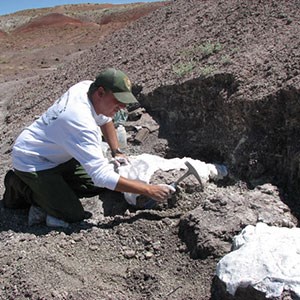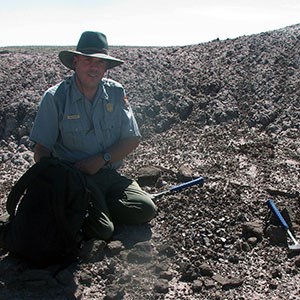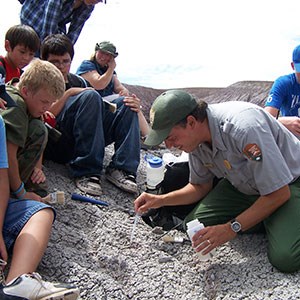Part of a series of articles titled Meet A Paleontologist.
Article
William (Bill) G. Parker, Petrified Forest National Park

Park Paleontologist, Petrified Forest National Park, Arizona
What is your job, and what do you study?
I am a vertebrate paleontologist working for the National Park Service at Petrified Forest National Park. I have worked at the park since 2001 and prior to that worked as a paleontologist for two years with the U.S. Forest Service. I work on Triassic age archosaurs (relatives of dinosaurs and crocodiles), which are very common fossils at the park. I also study the distribution of these fossils in the rocks, determining when species appear or go extinct in relation to each other. My job is fun because I get to do science at one of the most amazing places on earth, a National Park.

What are you working on now?
I'm currently focused on writing up descriptions of fossils that we find in the park. Quite a few turn out to be new species and need to be described for the first time. I also work on keeping our museum collection up-to-date and learning more about the park geology.
Where did you go to school? What were some of your favorite classes that you took?
I have Bachelors and Masters degrees in geology from Northern Arizona University and a Ph.D. from the University of Texas at Austin. However, I started my college work at a small community college in Mesa, Arizona. My favorite class was Historical Geology, which I took at this community college. The instructor was passionate about geology and took me on my first fossil (invertebrates) collecting trip. I was hooked.

Was there an experience you had that made you realize you wanted to be a paleontologist?
I was already working in a completely different career as a manager when I decided to quit that job and go to college. I had enjoyed fossils as a child but had not really thought about them since. About the time I was looking to go to college my mother gave me a dinosaur calendar for my birthday and I was intrigued at how different dinosaurs were being portrayed from when I was a kid. I decided I wanted to learn why and enrolled in geology classes. Of course after my first collecting trip I was hooked and this was reinforced when I got a chance to collect dinosaur bones in South Dakota.
What is your most memorable experience working with fossils?
I have had some amazing discoveries at the Petrified Forest, but my most memorable experience was that of being the second person to stumble across a hadrosaur dinosaur bone-bed in South Dakota. I remember not being able to walk without stepping on fossils. At one point I picked up two rocks and fitting them together was holding a complete skull of a juvenile dinosaur in my hands.
Do you have any advice for aspiring paleontologists?
The more multi-disciplinary you are the easier your path as a paleontologist will be. Of course you need to take math and science classes, but also learn some statistics, photography, and even drawing. You will use all of it. My best advice though is to simply get your foot in the door early. Join a local paleontological society and go volunteer at your local museum. Interact with the scientists, be enthusiastic, but more importantly be helpful.
Last updated: July 27, 2018
